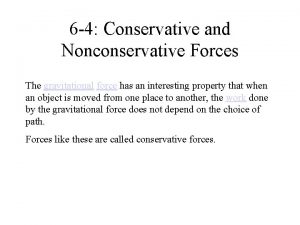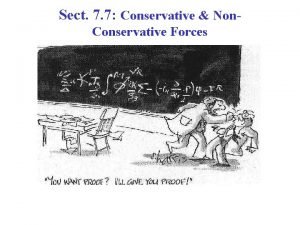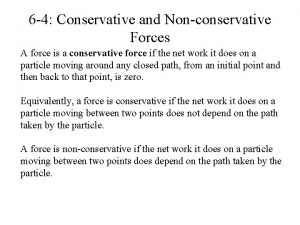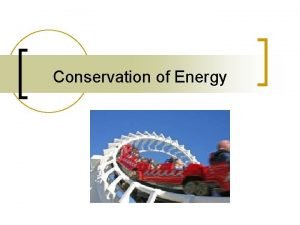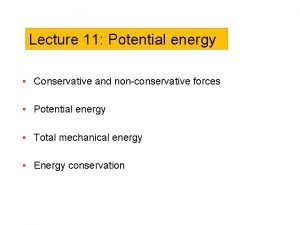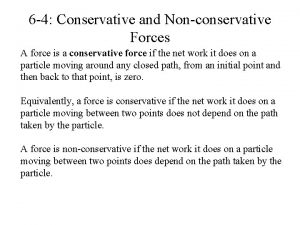Conservative and NonConservative Forces Changes in Mechanical Energy









- Slides: 9

-Conservative and Non-Conservative Forces -Changes in Mechanical Energy in the Presence of Friction AP Physics C Mrs. Coyle

What happens when friction is present? • When friction is present, the work done by the frictional force W=fd is transferred to heat energy. • The sum of the potential and kinetic energy of the system is not conserved. • Friction is a “non-conservative” force.

A Force is “Non-Conservative” if: • “the work it does on an object that moves between two points depends on the path taken. ” • “the work it does on an object that moves through a round trip is not zero. ” • Example: friction, tension, normal force, propulsion forces.

A Force is “Conservative” if: • “ the work this force does on an object that moves between two points depends only on the position of these two points and not on the path. ” • “the work this force does on an object that moves through a round trip is zero. ” • Example: gravity, force of a spring.

In the presence of friction, the mechanical energy of the system will decrease. • The change in mechanical energy will be negative and will equal the work done by friction. • ΔEmech =Emech final -Emech initial =-fd

Example 1 (#)21 A 4 kg particle moves from the origin to position C, having coordinates x=5 m and y=5 m. One force on the particle is the gravitational force acting in the negative y direction. Using W= F·r = Frcosθ, calculate the work done in going from O to C along a)OAC, b) OBC, c) OC. (See Fig. 1 on next slide. ) Your results should be all identical. Why? (Ans: -196 J)

Fig. 1 B C(5 m, 5 m) O A

Example 2 (#31) The coefficient of friction between the 3 kg block and the surface is 0. 4. The system starts from rest. What is the speed of the 5 kg ball when it has fallen 1. 5 m? Ans: 3. 74 m/s

Example 3(#38) • A 75. 0 kg skysurfer is falling straight down with a terminal speed of 60 m/s. Determine the rate at which the skysurfer-Earth system is losing mechanical energy. (Ans: d. E dt mech =mgv= 44. 1 k. W)
 Is gravitational force conservative or non-conservative why
Is gravitational force conservative or non-conservative why What is conservative force
What is conservative force Physics 03-01 work and the work-energy theorem
Physics 03-01 work and the work-energy theorem Force conservative et non conservative
Force conservative et non conservative A motorcyclist is trying to leap across the canyon
A motorcyclist is trying to leap across the canyon Forms of energy?
Forms of energy? Changes in latitudes, changes in attitudes meaning
Changes in latitudes, changes in attitudes meaning Chemical changes
Chemical changes Gravitational potential energy
Gravitational potential energy How to convert mechanical energy to electrical energy
How to convert mechanical energy to electrical energy
